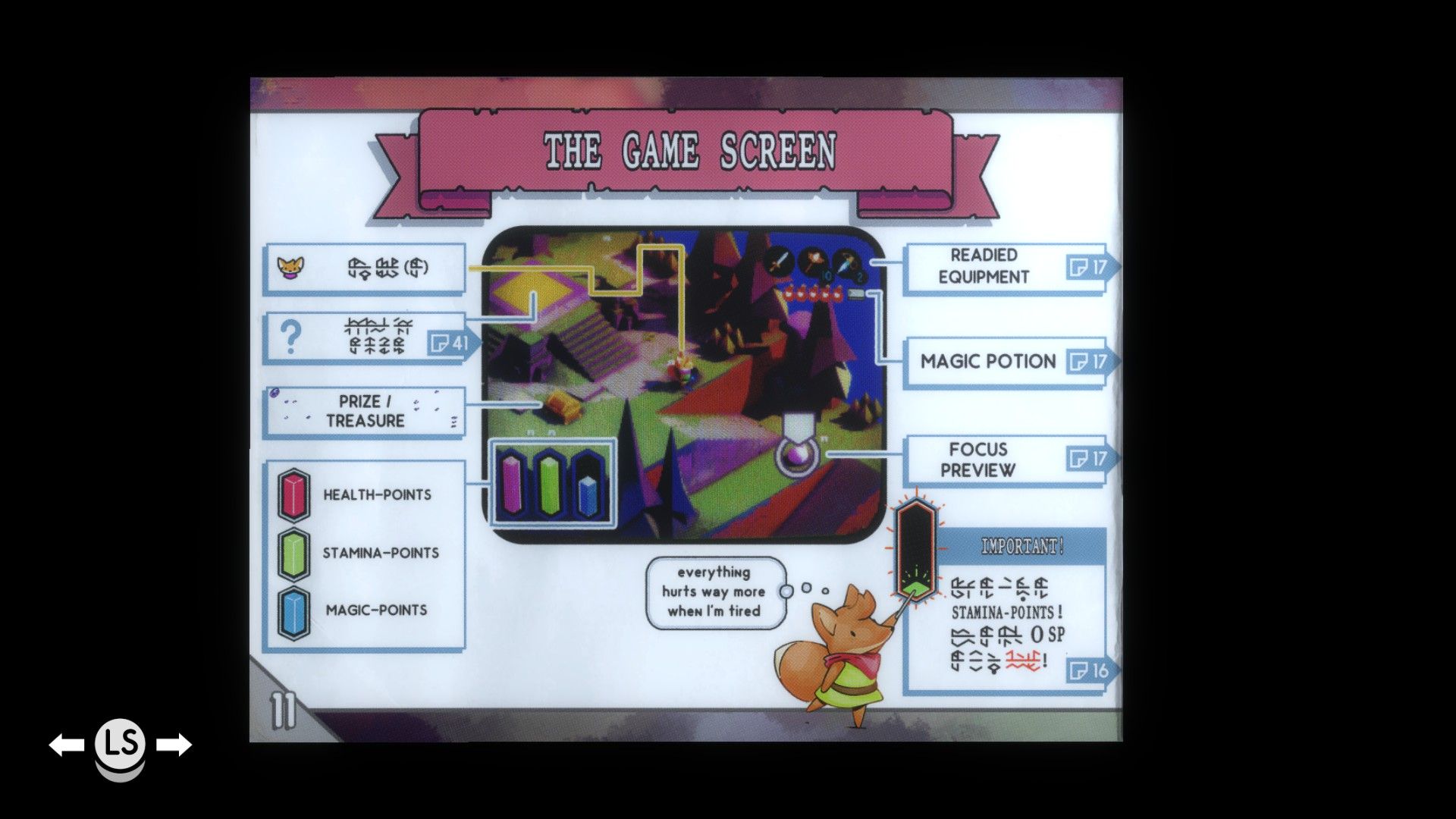Tunic script hints
You might have heard of Tunic. If not, go play it. If you like exploration-puzzle type games, Zelda games, or Metroidvanias, you will probably like it.
Tunic is interesting because most of its text is not written in Latin script. It has lots of dialog and in-game instruction booklet pages and other things written in a constructed script. It is real text, not random garbage. It looks like this:

I have a fondness for a certain kind of script. For example, Hebrew script, Korean Hangul, and Tolkien's Tengwar. Tunic's is such a script.
I also have a fondness for something like a "decoding aesthetic." Story of Your Life fits this mold. Heaven's Vault seems to fit, although I haven't played it yet to be sure. Outer Wilds is a near miss. Tunic is dead on.
In other words: You can decode the script. You are supposed to be able to. You don't have to to complete the normal came. You only need to learn it to collect the secret treasures. Just a few puzzles need it. But if you want to, and I did, you can.
Without further ado, I'll give some hints toward decoding the script. Thanks to the last page of the in-game instruction booklet and to this spoiler-safe hints guide on Steam for pointing me in the right direction.
Basics
This section isn't what I consider massive spoilers. It will get you on the right path if you want to decode rather than worrying about all the many many ways a script could correspond to words. These hints narrow down the space of possibilities a little bit to something manageable.
Hint 1: If you're feeling overwhelmed at the thought of figuring out a whole langauge, don't worry, because it's just English.
Hint 2: However, it's not so easy as a simple letter-swap.
Hint 3: It's a phonetic script, not an orthographic one. It is based on how words are spoken, not how they are spelled.
Center line and "tokenization"
Hint 1: What might these horizontal center lines mean?
Hint 2: The text can be split into symbols from left to right.
Hint 3/answer: Each horizontal center line groups the symbols that belong to the same word. So for example the center line will group every symbol in the word "potion."
Hint 4: Two consecutive symbols will never "bleed together" and make the text ambiguous. Each symbol is always recognizable without further context as long as you can figure out where its center is.
Symbols
Hint 1: Each symbol generally represents more than one thing.
Hint 2: Specifically, usually represents two things, and never more than two.
Hint 3/answer: A vowel, and a consonant. That is, each symbol represents either a vowel, a consonant, or both.
Dialect
Hint 1: Since this is a phonetic script you may be wondering what dialect it's based on. Note that things may become clearer once you get/look at page 26 of the booklet. More specifically, there's an arrow pointing to a fox. Even more explicit: The fox marker indicated appears on the map when you visit an area. Given that, what do you think the arrow says?
Hint 2 (yes the symbols are still visible, it's probably fine): Note that the word "a" is repesented with  while "are" is represented by
while "are" is represented by  . See how "are" doesn't have a second block. What does that tell you about the dialect? In what dialect do these words have a sound in common?
. See how "are" doesn't have a second block. What does that tell you about the dialect? In what dialect do these words have a sound in common?
Hint 3/answer: As far as I can tell the sounds are based on some non-rhotic dialect of English. Maybe that's (a variety of) British English — but I'm no expert, so who knows.
Deeper than symbols?
Hint 1: Each symbol can be decomposed into two parts, but in a spatially odd way (if you are analyzing symbols based on for example Korean Hangul).
Hint 2: The center line doesn't have anything to do with how the symbols should be decomposed. Ignore it.
Hint 3: Imagine the vertical lines "crossing over" the center line. Effectively they do.
Hint 4: Suppose you're extending the vertical lines as discussed in hint 2. Is there a simple geometric shape you can fit each symbol into?
Hint 5/answer to hint 4: The characters fit in a hexagon.
Hint 6: You can separate the symbol into two parts: The "outer edge" lines that correspond to edges of the hexagon, and the other stuff on the interior of the hexagon. (Ignore the center line, it's just for grouping.)
Hint 7: Not all \(2^6 - 1\) nonempty subsets of hexagon shells are possible. Moreover, the right edge will never be filled in, since it would overlap with the left edge of the next symbol.
Hint 8/big hint: The "hexagon shell" part is the vowel. The inner part is the consonant. There are 18 and 24 respectively.
The circle
Hint 1: The circle can be used with any C-V (consonant-vowel pair) symbol, not any ones in particular. That is, it can be used with for example "t oh" or "f oh" but not with the vowel-only "o" symbol, or with the consonant-only "t" or "f" symbols.
Hint 2: What can you do to change a sequence CV without deleting a sound or inserting any new sounds?
Hint 3/answer: It reverses the order of the two sounds, so a symbol for a sound "t oh" would become a symbol for "oh t" for example.